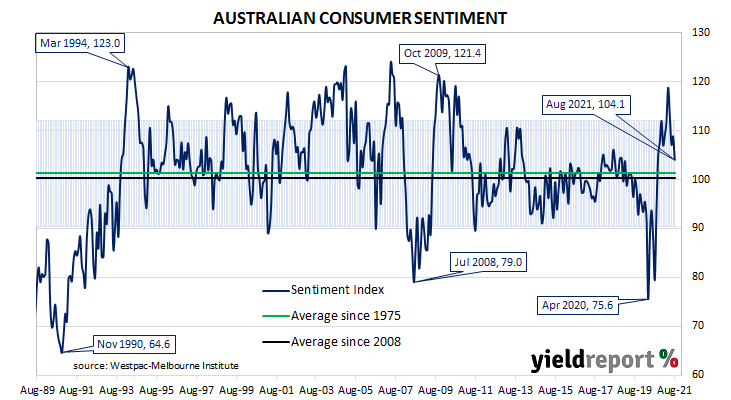Summary: Household sentiment deteriorates in August; significant loss of confidence “but better than might have been expected”; still above long-term average; distinct differences among states; all five sub-indices lower; unemployment index higher again.
After a lengthy divergence between measures of consumer sentiment and business confidence in Australia which began in 2014, confidence readings of the two sectors converged again around July 2018. Both readings then deteriorated gradually in trend terms, with consumer confidence leading the way. Household sentiment fell off a cliff in April 2020 but, after a few months of to-ing and fro-ing, it then staged a full recovery.
According to the latest Westpac-Melbourne Institute survey conducted in early August, household sentiment had deteriorated. The Consumer Sentiment Index decreased from July’s reading of 108.8 to 104.1.
“This is a significant further loss of confidence but better than might have been expected given virus developments,” said Westpac senior economist Matthew Hassan.
Any reading of the Consumer Sentiment Index above 100 indicates the number of consumers who are optimistic is greater than the number of consumers who are pessimistic. The latest figure is still above the long-term average reading of just over 101.
Domestic Treasury bond yields increased modestly on the day, lagging the overnight movements of their US Treasury bond counterparts. By the close of business, 3-year, 10-year and 20-year ACGB yield had all added 2bps each to 0.34%, 1.22% and 1.84% respectively.
In the cash futures market, expectations of a change in the actual cash rate, currently at 0.03%, remained largely unchanged. At the end of the day, contract prices implied the cash rate would rise slowly to 0.235% by November 2022.
Confidence levels by state displayed some distinct differences. Victoria had the largest fall, while indices for New South Wales and Queensland also suffered. In contrast, Western Australia and South Australia “posted solid gains”.

